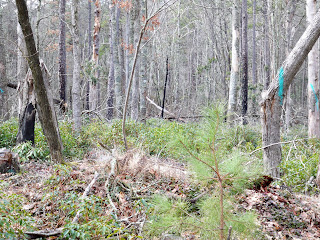I parked my truck at a pull off right before a ford in the creek. On foot, I followed an old logging road that was closed to vehicles. I hiked on this road for about a mile, seeing signs of a controlled-burn forest fire that looked as if it had taken place within the last 5-10 years, just a guess. Small pines were beginning to pop up around the base of larger deciduous trees. I heard water in the distance and went down the hill through some thick brush to get closer to the stream.
When I saw the light through the bushes, my next step was into a muddy marsh.. not exactly what I was expecting. I had arrived right in the middle of a marsh created by a string of beaver dams. I was excited to try my luck at fishing the beaver ponds, but it would show to be a very difficult part of the stream to fish. Part of the ponds were frozen, so not only were they impossible to fish, but I had to stray from the stream channel to move upstream to fish-able water. When I got to unfrozen portions of the ponds, I found that the water was crystal clear, just a normal occurrence for such ponds in the winter. With the water so clear, I assume that the fish were able to scatter long before I could reach a good position to cast my line. Wild trout have great senses. Pair this with a deep pool of little or no flow where the trout can sense vibrations more readily, and the advantage definitely goes to the fish. In the right conditions, beaver ponds can produce great numbers of large trout, but in February, it just wasn't happening.
As I moved on, the flow increased and the average depth decreased, still in the open sunlight. It was here that I saw my first brookie of the day, in fact, I almost stepped on it. I guess he was just as excited for the warm weather as I was, leaving a deeper pool for sunlit riffles in the sun. As I waded upstream, the channel began to narrow and resemble a textbook brook trout habitat. Rhododendron bushes didn't just encroach on the stream, they smothered it. With about half of my casts going into the stream and the other half going into the bushes. Let's just say some practice in my casting game wouldn't hurt.
I noticed several adult stoneflies clinging to my waders, these are one of the only types of insect that hatch during the winter. I switched to a fly pattern that I thought resembled the stoneflies and used it the remainder of the day. There were some great holes throughout this section. I saw a trout rise for my fly in one deeper run, but I failed to set the hook. I fished a few more similar spots until I arrived back at the ford where my truck was parked. My first fly fishing trip of the year had come to a close empty handed... and I was starving. A trip to Subway was in order.
I didn't catch anything, but trips like that are what make me respect native trout. They sure know a good hiding place when they see one. Their habitats are truly rough and I'm thankful that people have kept these backwoods areas intact for these fish to continue to thrive.
Has anyone got advice for fishing beaver dams? I'd like to hear your input in the comments below.







No comments:
Post a Comment